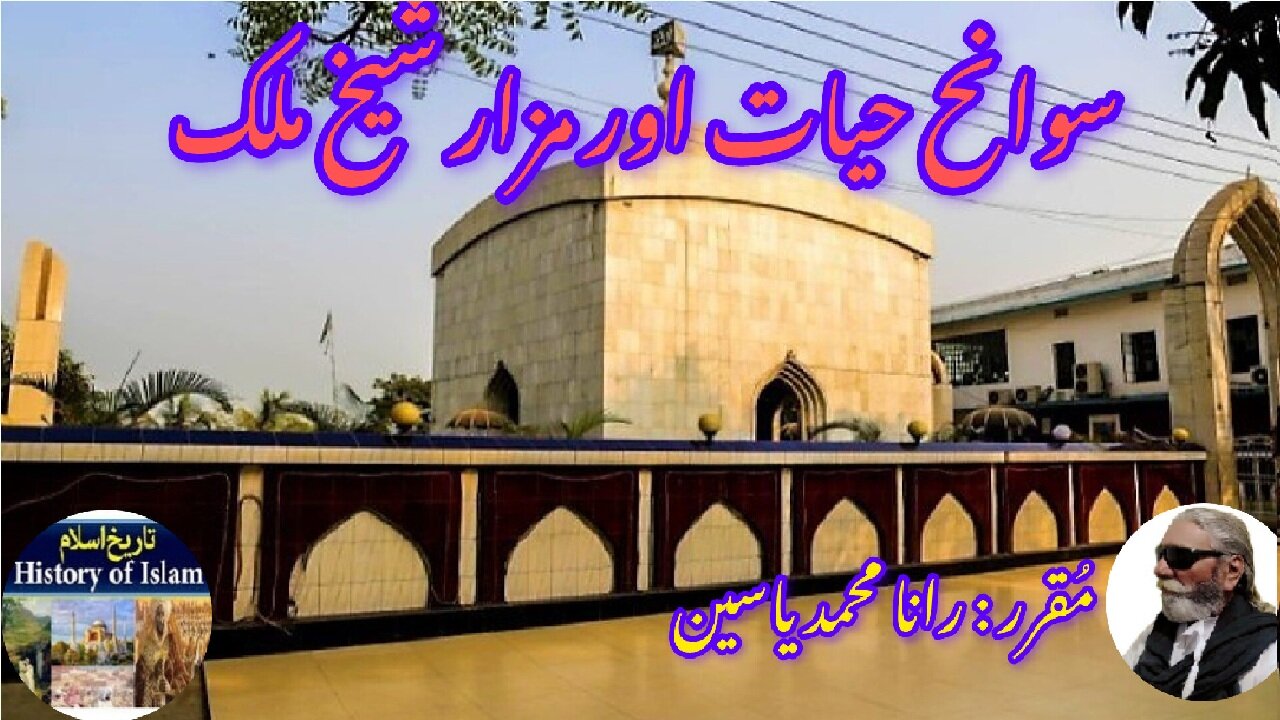Premium Only Content

Sheikh Malik and his shrine शेख मलिक और उनकी दरगाह شیخ مالک کی سوانح عمری اور مزار کی تاریخ
@islamichistory813 #shaykhmalik #sufisaint #culturalheritage #biography #islamicmysticism #islamicphilosophy #shrine #historicalfigures
Biography of Shaykh Malik and the history of his shrine
Dekhti Aankhooon aur sountay kaanoon ko Asslamoalaikum, sisters, brothers friends and elders, in informative series videos of Islamic ascolars, sufisaints, cultural heritages, islamic philosophys, islamic mysticisms and historical figures. today we are describing biography of Shaykh Malik and the history of his shrine.
Shaykh Malik, popularly known as Pir Yemeni, was a prominent Sufi saint who made significant contributions to the spread of Islam in the Indian subcontinent, particularly in Bengal. Hailing from Yemen, Pir Yemeni’s life and spiritual journey are deeply intertwined with the rich history of Islamic mysticism and the missionary work of Sufi saints in the region. His decision to leave his home country of Yemen and venture into the Indian subcontinent was driven by a deep sense of devotion to Islam and a desire to spread the teachings of the faith in regions that were in the process of embracing Islamic spirituality. His arrival in Bengal marked a significant chapter in the region's Islamic history, as he worked alongside renowned figures such as Shah Jalal and Shah Balkhi to further the cause of Islam.
Pir Yemeni’s spiritual journey brought him to the Indian subcontinent, where he became a key figure in the spread of Islam, particularly in the Bengal region. One of the most notable events in his life was his encounter with the famous Sufi saint Shah Jalal at the khanqah (spiritual lodge) of Nizamuddin Auliya in Delhi. This meeting proved to be pivotal for Pir Yemeni, as he soon became a close associate of Shah Jalal, one of the most revered Sufi figures in South Asia. The two men’s connection was not just spiritual but also strategic, as they joined forces for the conquest of Sylhet in 1303, a significant military campaign that led to the region’s integration into the Muslim world. Shah Jalal’s influence and leadership during this conquest were immense, and Pir Yemeni’s participation played a crucial role in establishing Islamic rule and spirituality in Sylhet, which later became a prominent center for the Muslim community in Bengal.
Following the successful conquest of Sylhet, Pir Yemeni’s missionary work took on a more focused direction. He, alongside Shah Balkhi, was assigned by Shah Jalal to continue the propagation of Islam in Dhaka, a rapidly growing and culturally significant region of Bengal. The task of preaching Islam in Dhaka was one of great importance, as the city was strategically located and played a vital role in the sociopolitical landscape of the region. Pir Yemeni and Shah Balkhi worked tirelessly to establish a strong Sufi presence in the city, with a special emphasis on building spiritual institutions such as khanqahs. These centers became vital hubs for the spiritual and educational development of the Muslim population in Dhaka, offering a place for worship, learning, and community building.
The khanqah that Pir Yemeni and Shah Balkhi established in Dhaka was situated near what is now the Secretariat Buildings of the Government of Bangladesh. This area, which has since become one of the central administrative districts of Dhaka, was once home to a thriving community of Sufi practitioners, intellectuals, and ordinary Muslims who found solace in the teachings and spiritual guidance of Pir Yemeni. The establishment of this khanqah in such a prominent location helped to strengthen the Islamic presence in Dhaka and laid the foundation for the future growth of the Muslim community in the city.
Pir Yemeni’s spiritual influence and teachings were deeply rooted in the Sufi tradition, which emphasizes the purification of the soul, love for God, and service to humanity. As a Sufi master, Pir Yemeni was known for his deep piety, his devotion to the welfare of others, and his ability to guide his followers on the path of spiritual enlightenment. His teachings resonated with a wide range of people, including both the elite and the common folk, who were drawn to his humility and commitment to the principles of Islam. Pir Yemeni’s ability to connect with people from all walks of life made him a beloved figure in the region, and his legacy continues to inspire the people of Bangladesh to this day.
After his death, Pir Yemeni’s influence continued to endure, particularly through the shrine that was built in his honor. The shrine of Pir Yemeni, located in Dhaka, has become a significant site of pilgrimage for Muslims, particularly those in the Ahl-i-Sunnat and Sufi communities. Devotees visit the shrine to seek blessings, offer prayers, and reflect on the spiritual lessons imparted by Pir Yemeni during his lifetime. The shrine is not only a place of religious reverence but also a symbol of the enduring impact of his work in spreading Islam in Bengal. Over the centuries, the shrine has become a focal point for spiritual and cultural gatherings, where people come to connect with the legacy of a man who dedicated his life to the service of God and the propagation of Islam.
The shrine of Pir Yemeni is also a testament to the broader history of Sufi saints and their role in shaping the religious and cultural identity of the Indian subcontinent. Sufi shrines, including that of Pir Yemeni, continue to serve as places of spiritual renewal, where people from diverse backgrounds come together to celebrate the shared values of love, peace, and spiritual devotion. These shrines are often places where the teachings of the saints are passed down through oral traditions, including religious poems, songs, and stories that continue to be performed by ashiks and other folk artists. The legacy of Pir Yemeni, much like other Sufi figures, lives on through the vibrant traditions and practices that have evolved around his shrine and the communities that revere him.
In conclusion, Pir Yemeni’s life and work in the Indian subcontinent, particularly in Bengal, played a significant role in the spread of Islam and the establishment of Sufi spirituality in the region. His association with Shah Jalal and his efforts in the conquest of Sylhet, as well as his missionary work in Dhaka, have left an indelible mark on the history of Bengal. The shrine of Pir Yemeni in Dhaka stands as a lasting symbol of his spiritual legacy and his contributions to the cultural and religious development of the region. His teachings, centered on love, humility, and service to humanity, continue to inspire people today, and his shrine remains a place of pilgrimage and spiritual reflection for Muslims in Bangladesh and beyond.
With this, we seek your permission until tomorrow, tomorrow we will describe the biography of Muhammad Alauddin Siddiqui and the history of his Shrine.
========================
-
 7:21
7:21
ISLAMIC HISTORY
5 hours agoBiography of Scholar Abu al-Hasan Sari (al-Sari) سوانح حیات ابو الحسن ساری (الساری)
4 -
 LIVE
LIVE
Kim Iversen
49 minutes agoAre The "Fat Generals" Just A Cover For War With Iran?
823 watching -
 LIVE
LIVE
Candace Show Podcast
1 hour agoDEAD OR ALIVE: Who Betrayed Charlie Kirk? | Ep 245
8,232 watching -
 1:40:32
1:40:32
Redacted News
2 hours ago"This was 100% a CIA hit!" Charlie Kirk's Assassination Story COLLAPSES Amid New Evidence | Redacted
88.1K83 -
 39:40
39:40
The White House
3 hours agoPresident Trump Signs Executive Orders, Sep. 30, 2025
19.1K24 -
 1:06:26
1:06:26
vivafrei
3 hours agoLive with Alexa Lavoie! ANTIFA in Canadian Government? RCMP the New Gestapo? AND MORE!
128K38 -
 40:38
40:38
Dad Saves America
23 hours agoLeft Is Right, Up Is Down: The Overton Window Has Been Shattered
5.52K1 -
 LIVE
LIVE
LFA TV
18 hours agoBREAKING NEWS ALL DAY! | TUESDAY 9/30/25
1,128 watching -
 LIVE
LIVE
freecastle
6 hours agoTAKE UP YOUR CROSS- May the forces of evil become confused on the way to your house.
242 watching -
 1:23:05
1:23:05
Awaken With JP
5 hours agoGetting NUTS! FBI Did J6, Comey Indicted, and More! - LIES ep 110
55K25